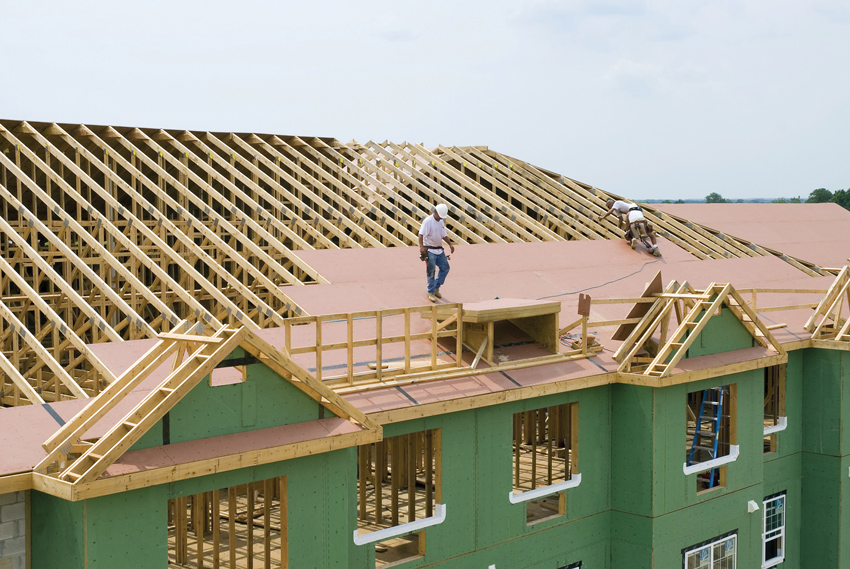High-Performing, Resilient, Wood-Framed Roofs
Standards and Programs Influencing Design
Recognizing the importance of assuring the integrity of a roofing system, a number of organizations and agencies have developed guidelines and standards for design and construction. These include model building codes, regional and federal standards, and industry programs. In terms of codes, the International Building Code (IBC) and the International Residential Code (IRC) have established specific requirements for wood-framed roof construction to provide durable materials guidelines for the sake of public safety. These codes are either adopted directly or are the basis of most of the code requirements in the United States related to the assembly of wood-framed roofing systems. They address all of the components collectively, acting as part of a functioning system, while in some cases they prescribe certain items or materials as safeguards.
In terms of relevant standards, the Federal Emergency Management Agency (FEMA), for example, has produced a series of 37 fact sheets to provide technical guidance and recommendations aimed at improving the performance of buildings subject to flood and wind forces in coastal environments. Known as FEMA 499, these recommendations are not requirements unless the local code references the document, although they are considered good practice in coastal regions. One of these FEMA recommendations suggests taping the seams of roof sheathing panels to provide better protection against water infiltration if the roof covering ever blows off. Such infiltration during a severe storm can lead to a tremendous amount of water damage inside the home. In the experience of North Carolina custom home builder John Paul Corey of East Carolina Construction, taped panels held up very well on his projects after Hurricane Irene battered the North Carolina coast in August 2011, producing winds in excess of 80 miles per hour. “Other projects in the area had either tar paper on the roof or building wrap on the exterior, and 60 to 70 percent of their materials blew off during the storm that then had to be replaced,” notes Corey.
Another voluntary program that can yield homeowner insurance savings has been developed by the Insurance Institute for Business & Home Safety (IBHS). This organization is an independent, nonprofit, scientific research and communications organization supported solely by property insurers and reinsurers. IBHS’s building safety research has led to real-world solutions for home and business owners, helping to create more resilient communities. It has developed a program known as the FORTIFIED Home™, which is “a set of engineering and building standards designed to help strengthen new and existing homes through system-specific building upgrades to minimum building code requirements that will reduce damage from specific natural hazards.”4 Homes built to FORTIFIED Homes standards are inspected by a FORTIFIED Homes professional and certified as compliant. Homeowners don’t just walk away with a certification, but an important piece of documentation they can then take to their home insurance companies to help significantly, in some areas, reduce their homes’ insurance premiums. The amount of savings will vary based on location and circumstances, but can be significant.

©2013 Huber Engineered Woods LLC
The roof construction of a building is a fundamental item to address under the FORTIFIED™ Home standard intended to improve resiliency and possibly reduce property insurance costs.
The FORTIFIED Home program has three levels of designation—Bronze, Silver, and Gold—that build upon each other, allowing designers to choose the desired level of protection best suited to the project budget and resiliency goals. The critical component of resilient design, according to FORTIFIED Homes, is the roof system, which is part of every designation level. Recommended practices to achieve any of these designations include taped roof sheathing seams to reduce wind and water entering the attic through the roof covering and vents. One all-in-one roof sheathing system incorporates a structural engineered wood panel with a built-in water-resistive barrier with advanced acrylic adhesive tape to seal panel seams. This simple two-step system eliminates the need for felt and the chance of water getting trapped between the sheathing and water barrier, under a high-wind event, if the roof covering is blown off. In many areas, the residential building code does not require a sealed roof deck. However, a simulated hurricane test conducted by IBHS demonstrates how a sealed roof deck using advanced acrylic adhesive tape can help protect against water and wind penetration under extreme weather conditions.5 The cost differential of repairs IBHS has calculated due to water damage in this testing scenario compared to the minimal investment to tape a roof deck lays out a motivating, positive return on investment. Along with a sealed roof deck, the other components of FORTIFIED Bronze roof construction include ring shank nails for greater nail-hold capacity and uplift, as well as the need for structural sheathing on the gable ends and truss or rafter bracing to better resist lateral loads during high wind events. Once the roof is addressed, the Silver level then addresses windows, doors and attached structures. After the first two levels are achieved, then the Gold level ties the house together by connecting the roof to the walls to the floors to the foundation, so everything acts as one complete system.









